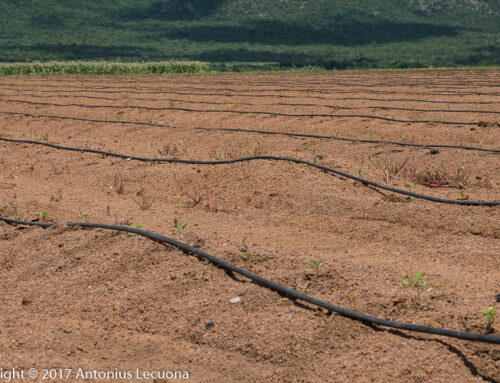
Effect of salt stress on bush beans
We know that the quality of irrigation water is slowly deteriorating in South Africa. The salt content of water is ever increasing due to uncontrolled mining activities, heavy industrial effluent being dumped into rivers and intensive agricultural practices. At the end, the grower is becomes limited in what can commercially be grown (and I mean with making good profits). Increase in salt content of farming soils is also caused by incorrect irrigation management. One of the big culprits is drip irrigation. But more on that later.
The grower sits with either high salt content in the irrigation water or in the soil or both. Which one is first, well that is the chicken and egg argument. In some cases, where there is high concentration of mining activities, it is usually the irrigation water that causes the problems and pollutes the soil. In very intensive agricultural regions, the soil is first contaminated and later the irrigation water. Both cases growers have high salt content in the water and in the soil.
So before deciding to plant green beans have your irrigation water and soil water tested. If the value is less than 1.1 dS/m you are ok. If the EC is higher, you will run into problems.
ASSIMAKOPOULOU (2015)1 found that there are some varieties that are more tolerant to salt stress than others. This is good news for growers that have a basket of varieties to their disposal, but in South Africa we only have a few to choose from. The first step for a growers is to plant all the varieties that are available on a small piece of land and continuously monitor the plant. It was shown that some varieties have the ability to maintain K/Na and Ca/Na ratios in the leaf even at high Na concentration in the soil. Some varieties showed a 45% yield drop due to the high salt content.
The first signs of low salt tolerance is stunted growth. Leaves will be smaller and the general turgor of the plant will be much lower. One can expect a higher incidence of disease and insects pressure later in the season as the cell walls will be thinner. In general the plant is weaker and has less resistance to temperature shocks. Many growers have also found that the blossoms start to fall in lower temperatures compared to more ideal conditions.
BOUTRAA & SANDERS (2001)2 found that water stress during flowering and pod filling caused reduced yield and yield components. So one could expect a reduction in seed weight, number of seeds per plant and number of pods per plant. Tolerant varieties tend to accumulate more sodium in their roots while maintaining the right balance in the leaves. Although their research was more focussed on arid dry areas where the absolute volume of water was reduced, it has very much the same effect as high salt content, without the high Na and Cl ions. High salt reduces the plant’s ability to absorb water due to the osmotic process of water uptake.
We know that the quality of irrigation water is slowly deteriorating in South Africa.
So what can you expect with high salt content:
- Reduced yields, up to 60% with some varieties
- There is a significant variation to the reaction of varieties to salt stress
- Slightly longer time to reach maturity
- Smaller seeds
- Lower seed count per plant
- Less pods per plant.
- Leaves are smaller
References
- ASSIMAKOPOULOU, et al. Effect of Salt Stress on Three Green Bean (Phaseolus Vulgaris L.) Cultivars. Notulae Botanicae Horti Agrobotanici Cluj-Napoca 43.1 (2015): 113-118. Web
- BOUTRAA, T., and SANDERS, F.E. In Influence of Water Stress on Grain Yield and Vegetative Growth of Two Cultivars of Bean (Phaseolus vulgaris L.). J. Agronomy & Crop Science 187, 251-257 (2001)





